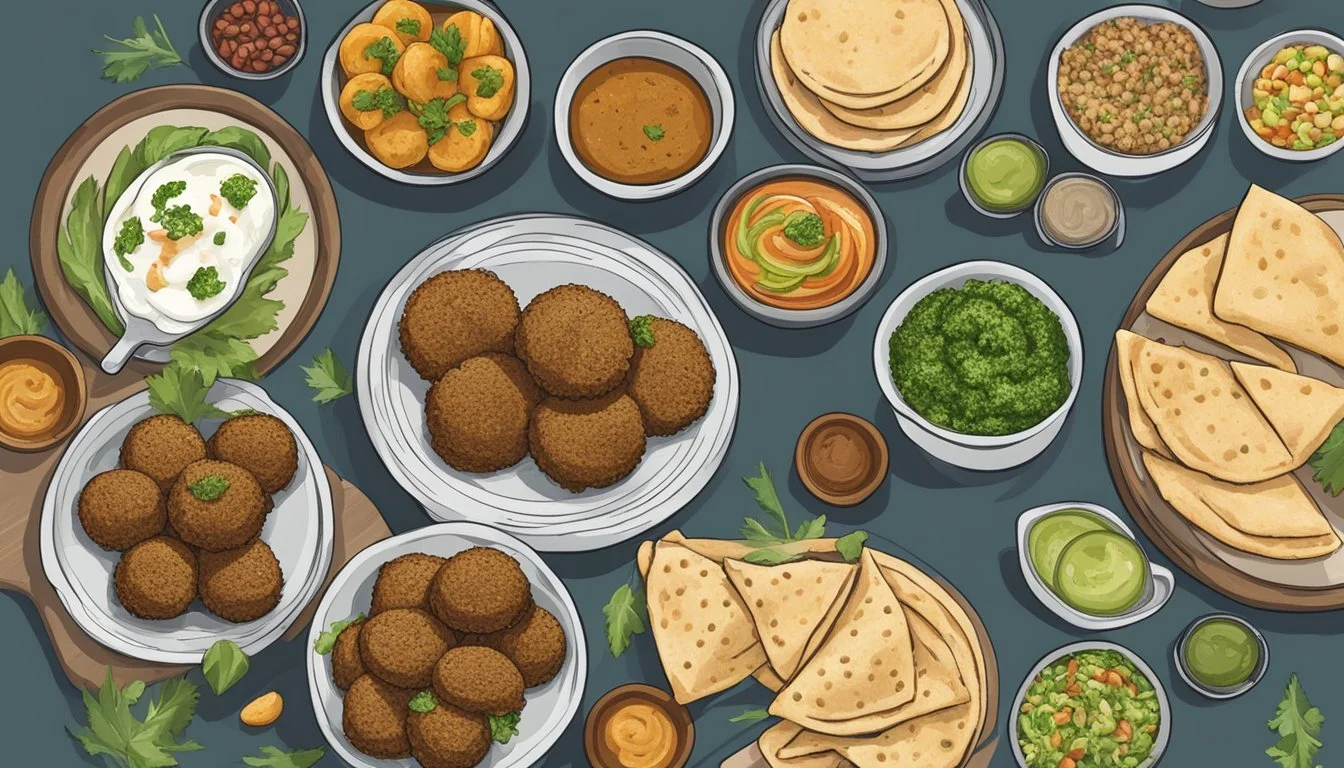Is Falafel Gluten-Free?
Understanding Its Ingredients and Preparation
Falafel, a popular Middle Eastern dish, traditionally consists of ground chickpeas or fava beans mixed with herbs and spices, then shaped into balls or patties and deep-fried. This food item has gained immense popularity across the globe not only for its taste but also for its potential to be gluten-free and vegan, accommodating a wide range of dietary preferences.
The question of whether falafel is gluten-free hinges on the ingredients and preparation methods. In its purest form, falafel does not contain gluten, as the main components—chickpeas, herbs, and spices—are naturally devoid of this group of proteins found in grains like wheat, barley, and rye. This makes falafel a viable option for individuals looking to avoid gluten, including those with celiac disease or gluten sensitivity.
However, the gluten-free status of falafel can be compromised through cross-contamination in kitchens where gluten-containing foods are also prepared. For example, using the same oil to fry falafel and breaded items like onion rings introduces gluten to an otherwise gluten-free dish. Vigilance is thus essential for those with severe reactions to gluten, from selecting restaurants that maintain strict gluten-free preparation practices to choosing pre-made falafel mixtures that are certified gluten-free.
What is Falafel?
Falafel is a widely enjoyed Middle Eastern delicacy, frequently found being served as street food. It typically consists of spiced, ground chickpeas or fava beans formed into balls or patties. These are then deep-fried until they achieve a crispy exterior, with a soft and flavorful interior.
Origin: Middle Eastern cuisine
Ingredients: Chickpeas or fava beans, herbs, spices
Preparation: Formed into balls/patties, deep-fried
Texture: Crispy outside, tender inside
Diet: Vegetarian, often vegan-friendly
This dish not only carries the cultural flavors of its homeland, but it's also a favorite among those who follow a vegetarian or vegan diet. With the upsurge of interest in plant-based diets, vegan falafel has gained popularity due to its nutritious profile and absence of animal products. Its versatility allows it to be tucked inside flatbreads, tossed in salads, or served as part of a mezze platter, making it a cherished choice for mealtime.
Falafel's flavor comes from a blend of herbs, such as parsley and cilantro, and spices like cumin and coriander, which complement the nutty taste of the chickpeas. Despite its simple ingredients, the preparation requires mastery to achieve the perfect falafel: a golden-brown crust with a steaming, aromatic center that delights the palate.
Falafel Ingredients
The foundation of falafel lies in its simple, yet flavorful ingredients. Chickpeas serve as a base, bolstered by the zest of fresh herbs and spices, with selective binding agents to maintain form.
Chickpeas and Fava Beans
Chickpeas, also known as garbanzo beans, are a staple component in traditional falafel recipes, valued for their rich texture and protein content. Fava beans can also be used, either in concert with or as a substitute for chickpeas. These legumes are typically soaked overnight to soften before being ground for the falafel mixture.
Chickpeas (Garbanzo Beans): Soaked, and sometimes cooked, before grinding.
Fava Beans: An alternative or complement to chickpeas, often soaked as well.
Herbs and Spices
Herbs and spices infuse falafel with its characteristic flavors. Parsley, cilantro, or sometimes a mix of fresh herbs are chopped and folded into the falafel blend. Garlic and onion are minced and added to impart a savory depth. Ground cumin along with salt and pepper provide the warm, aromatic spice profile that defines the falafel's appeal.
Garlic and Onion: Minced for a robust flavor base.
Fresh Herbs: Typically parsley and/or cilantro, finely chopped.
Spices: Ground cumin, along with salt and pepper for seasoning.
Additives and Binding Agents
Binding agents such as flour may be introduced to the falafel mix to help the ingredients adhere and maintain their shape during cooking. However, to keep the falafel gluten-free, one must use gluten-free flour or avoid flour altogether. Other additives like baking powder can be added to achieve a lighter texture.
Flour: Gluten-free options are available for those with sensitivities.
Baking Powder: Sometimes used for leavening, creating a lighter texture.
Is Falafel Gluten-Free?
Falafel's gluten-free status depends on its ingredients and preparation methods. Individuals with celiac disease or gluten sensitivities should be particularly vigilant about cross-contamination risks.
Ingredients Analysis
Traditionally, falafel is made from ground chickpeas, which are inherently gluten-free. Other common ingredients include herbs, garlic, onions, and spices such as cumin and coriander. However, some recipes or commercial mixes might include flour or additives containing gluten as binders or fillers. It is crucial for consumers to review ingredient labels or ask about the recipe when purchasing falafel.
Cross-Contamination Risks
Cross-contamination is a significant concern for those with gluten-related disorders. Even if falafel is made with gluten-free ingredients, cooking it in the same fryer as breaded items like onion rings can contaminate it with gluten.
Key Points to Consider to Avoid Cross-Contamination:
Ensure separate cooking equipment is used.
Ask about the frying procedures at restaurants.
Check if the establishment has a dedicated gluten-free menu or fryer.
Gluten-Free Recipe Alternatives
For those making falafel at home, various gluten-free alternatives can be used to keep the recipe safe for celiac or gluten-sensitive individuals. Instead of wheat flour, options like almond flour, rice flour, or gluten-free all-purpose flour can serve as effective binders.
Simple Gluten-Free Falafel Recipe Guidelines:
Soak gluten-free chickpeas overnight.
Blend with herbs, garlic, and gluten-free spices.
Bind with a gluten-free flour alternative.
Fry in a dedicated gluten-free cooking environment.
Preparing falafel at home allows for greater control over the ingredients and cooking process, substantially reducing the risk of cross-contamination.
Preparing and Cooking Falafel
Preparing and cooking falafel requires attention to detail, particularly with the initial preparation of legumes and the chosen cooking method, be it frying, baking, or using an air fryer. Ensuring gluten-free status depends on the absence of gluten in all ingredients and avoiding cross-contamination during the cooking process.
Soaking and Grinding Legumes
Legumes, typically chickpeas, are the foundation for falafel. They need to be soaked overnight or at least for 10 hours to soften and hydrate them properly. After soaking, the chickpeas are drained and then ground into a coarse mixture using a food processor. This preparation stage is crucial as it affects the falafel's texture and its ability to bind properly without disintegrating during cooking.
Forming and Frying the Patties
Once the mixture is ground, it is shaped into small patties or balls. A heavy-bottom skillet or electric fryer should be filled with about 2-3 inches of a suitable oil, such as vegetable or canola, and heated to 350°F. Patties are then fried until they are golden brown, typically for a few minutes on each side. It's important to ensure the cooking oil is not shared with gluten-containing foods to maintain a gluten-free meal.
Baking and Air Frying Alternatives
Baking and air frying are healthier alternatives to the traditional frying method. When baking, the falafel patties are placed on a baking sheet and cooked in an oven typically preheated to around 375°F. Cook time can vary but generally ranges from 20 to 30 minutes, flipping halfway to achieve even crispiness. For air frying, the air fryer should be preheated, and the cook time is usually less than oven baking, producing a result similar to deep frying but with significantly less oil.
Serving and Accompaniments
Falafel can be enjoyed with a variety of sides, dips, and gluten-free bread, each offering a unique flavor and texture to complement the chickpea patties.
Traditional Sides
Falafel is commonly paired with a selection of traditional sides that enhance its taste. They often include:
Salads: such as tabbouleh or a simple chopped salad dressed with lemon and olive oil.
Pickled Vegetables: (What wine goes well with pickled vegetables?) which add a refreshing burst of acidity.
Fried Vegetables: like cauliflower, which offer a satisfying crunch.
Sauces and Dips
No falafel meal is complete without its sauces and dips. They bring moisture and richness to the falafel balls. Key options include:
Tahini Sauce: a creamy sesame-based sauce offering a nutty flavor.
Hummus: a smooth chickpea spread that provides a creamy texture.
Gluten-Free Bread Options
While traditional falafel is served in pita bread, those requiring a gluten-free diet can opt for:
Gluten-Free Pita Bread: specifically made without gluten, ensuring a safe accompaniment for the falafel.
Lettuce Wraps: a low-carb and fresh alternative, perfect for wrapping the falafel and accompaniments.
Nutritional Information
Falafel is often praised for its nutritional value, particularly when it comes to calories, protein, fiber, and fat content. A typical serving of falafel, which may consist of about 3 to 4 balls, contains approximately 330 calories. The exact number can vary depending on the size of the falafel and the preparation method.
In terms of protein, falafel is a substantial vegetarian source, providing about 13 grams per serving. This is largely attributed to its main ingredient, chickpeas, which are rich in protein.
Fiber also plays a significant role in the health benefits of falafel, primarily due to the presence of chickpeas and herbs. A serving can have approximately 5 to 6 grams of fiber, which is instrumental in promoting healthy digestion and contributing to the feeling of fullness.
Regarding fat, falafel can contain around 17.5 grams. It is important to note that this value can greatly increase if the falafel is deep-fried, as opposed to being baked. The fat content mainly consists of unsaturated fats, which can be beneficial when consumed in moderation.
Here's a breakdown of the nutritional elements in falafel:
Calories: ~330 kcal per serving
Protein: 13 g
Fiber: 5-6 g
Fat: 17.5 g
Falafel's nutritional profile can fit into various dietary patterns, offering a satisfying option that is both flavorful and nutrient-dense.
Storing and Reheating
When it comes to preserving the freshness of falafel, proper storage is crucial. Leftovers should be placed in an air-tight container and refrigerated. This method helps maintain their quality and extends their shelf life. If a consumer plans to keep them longer, falafel can be frozen, allowing them to retain their taste and texture for a future meal.
Reheating falafel is straightforward, ensuring they can be enjoyed almost as if freshly made. To reheat refrigerated falafel, the oven is often recommended. Heating them at 350°F for 5-10 minutes is typically sufficient. An air fryer can also be an effective tool; reheating at 350°F for about 5 minutes should yield a warm and crispy result.
Here are the recommended steps:
Preheat the oven or air fryer to the desired temperature.
Arrange the falafel on a baking sheet or in the air fryer basket, ensuring they’re not touching.
Heat until they are warmed through and regain a desirable crispiness.
In avoiding the microwave for reheating, diners can ensure their falafel does not become soggy. Instead, using the aforementioned methods can help preserve the desirable outer crunch and inner softness that make falafel a satisfying dish.
Finding Gluten-Free Falafel in Restaurants
When dining out, finding gluten-free falafel can be a challenge, yet it is not impossible—especially as awareness of gluten sensitivities increases. Patrons looking for Israeli food What wine goes well with Israeli food? or dishes with Arab roots, such as falafel, which also has ties to Egypt and Lebanon, must inquire specifically about gluten-free options.
Inquire About Preparation Methods:
It's crucial to ask if the falafel is made with chickpea flour alone, as traditional recipes usually require.
One should confirm whether the falafel is fried in a dedicated gluten-free fryer to avoid cross-contamination.
Research the Restaurant:
Prior to visiting, check if the restaurant's menu contains a gluten-free section.
Verify if the establishment acknowledges cross-contamination concerns, indicating a higher level of gluten-free safety standards.
Considerations for Eating Out:
Ingredients: Verify the absence of wheat flour or other gluten-containing binders in falafel.
Preparation Area: Ensure separate prep surfaces and utensils are used for gluten-free dishes.
Fryers: Confirm that falafel is cooked in clean oil, not shared with gluten-containing foods.
By taking these steps, diners can enjoy falafel with greater confidence in adhering to their gluten-free dietary needs.
Making Falafel at Home
Creating gluten-free falafel at home can be a straightforward and satisfying process, given the right recipe, tools, and techniques. This section will guide the reader through selecting a gluten-free falafel recipe, outlining the necessary equipment and tools, and providing tips to ensure a perfect falafel result.
Gluten-Free Falafel Recipes
A gluten-free falafel recipe typically requires chickpeas as the base ingredient. The chickpeas should be soaked overnight or for at least 10 hours to ensure proper hydration. Speeding up this process is possible by boiling water, adding the chickpeas, covering the pot, and letting them sit for an hour before draining. Key ingredients also include onion, garlic, parsley, cumin, salt, pepper, and baking soda, which add flavor and help in binding the falafel together. One must be cautious to ensure all additional ingredients, such as spices or baking powder, are also gluten-free.
Equipment and Tools
Food Processor: A food processor is essential in achieving a coarse, well-combined falafel mixture.
Cooking Oil and Thermometer: Most recipes recommend frying the falafel, which requires a cooking oil with a high smoke point, and a thermometer to monitor the oil's temperature accurately.
Utensils:
Measuring cups and spoons for accurate ingredient portioning.
Sheets of parchment paper or plates to hold shaped patties.
A heavy-bottom skillet or electric fryer for stable frying temperatures.
Tips for the Perfect Homemade Falafel
Chickpea Preparation: To avoid a mushy texture, one should not use canned chickpeas as they tend to be too wet. Dried chickpeas, soaked and then drained, provide the best consistency.
Patty Formation: Scooping about two tablespoons of the mixture and shaping it into patties of approximately 1 1/2-inches wide and 1/2-inch thick ensures even cooking.
Oil Temperature: Maintaining an oil temperature between 340°F to 350°F is crucial; too low and the falafel will absorb too much oil and become greasy, too high and it may burn.
Total Time Commitment: Including prep, the total time to make homemade gluten-free falafel may vary, but one should allocate a couple of hours from start to finish for the best results.
By following a gluten-free recipe and using the correct equipment, plus applying these tips, making falafel at home can be a delicious success.
The Origins and Cultural Significance of Falafel
Falafel has long been celebrated as a quintessential Middle Eastern food, with its origins deeply rooted in the history of the region. The exact birthplace of falafel is commonly contested; however, many scholars attribute Egypt as the likely originator where it was initially made with fava beans.
Arab Roots: The food's popularity is not confined to its supposed Egyptian beginnings. Across the Middle East, from Lebanon to Yemen, falafel is both a staple and a delicacy, intricately woven into the culinary traditions of Arab cultures.
Israeli Influence: Over time, falafel has also been embraced by Israeli cuisine, becoming a national dish often served in pita bread with salad and tahini sauce.
Ingredients: Typically, falafel is made from ground chickpeas or fava beans blended with herbs and spices.
Preparation: These ingredients are shaped into balls or patties and deep-fried until they achieve a golden exterior with a moist interior.
The dish exemplifies a convergence of culinary practices in the region, transcending political and cultural borders to emerge as a universally beloved food. It's a testament to the Middle East's rich and diverse gastronomic landscape.
Given its traditional use of wheat-based ingredients, falafel is not inherently gluten-free. However, contemporary adaptations often omit breadcrumbs or employ gluten-free options to cater to those with dietary restrictions.
By honoring its past and evolving with contemporary dietary needs, falafel not only endures but thrives as a symbol of Middle Eastern cuisine.
Common Questions about Falafel and Gluten
Falafel, a popular Middle Eastern dish traditionally made from ground chickpeas, herbs, and spices, garners attention from those on gluten-free diets due to potential cross-contamination and ingredient variations. Here are some focused insights into common concerns regarding falafel consumption for individuals with gluten sensitivities.
Can Celiac Disease Sufferers Eat Falafel?
Individuals with celiac disease must adhere to a strict gluten-free diet to avoid health complications. While falafel is often made with naturally gluten-free ingredients, the cooking environment poses risks. Cross-contamination, especially when falafel is fried in oil also used for gluten-containing foods such as breaded onion rings, can render it unsafe. Celiac sufferers should only consume falafel that is confirmed to be prepared in a gluten-free environment to ensure their health is not compromised.
How to Identify Gluten in Falafel
To determine if falafel is gluten-free, reviewing ingredient labels or inquiring about ingredients is key. Traditional falafel recipes use chickpea flour, which is gluten-free, but sometimes wheat flour is added for binding or texture. Look for these indicators of gluten:
Ingredient labels: Check for wheat, barley, rye, or any derivatives.
Vendor practices: Ask if the falafel is made in-house and whether the facility handles gluten-containing products.
Certifications: Gluten-free certifications on packaging can also provide reassurance.
Tips for Eating Out with Gluten Sensitivity
When dining out with gluten sensitivity, it's essential to communicate needs clearly to restaurant staff. Here are a few tips:
Ask questions: Inquire about ingredients and preparation methods specifically related to gluten.
Seek dedicated gluten-free options: Restaurants that offer a dedicated gluten-free menu or have a known protocol for handling gluten-free dishes are generally safer choices.
Be cautious with sauces and condiments: These can be hidden sources of gluten, so it's important to confirm their safety.
Consider cross-contamination: Be aware that shared cooking surfaces can contaminate otherwise gluten-free foods.










